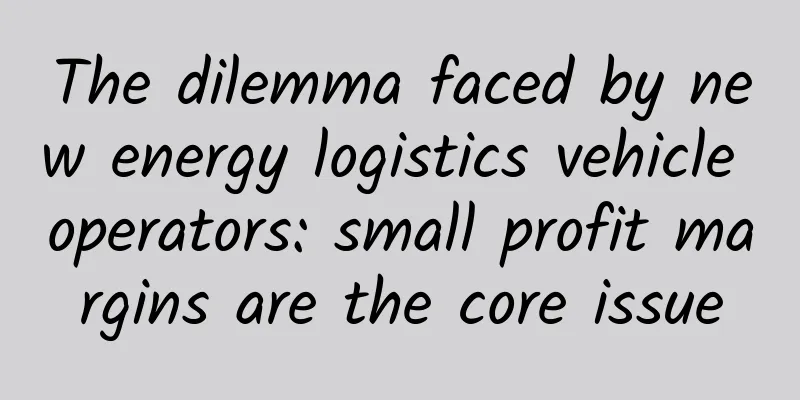The dilemma faced by new energy logistics vehicle operators: small profit margins are the core issue

|
New energy vehicles are supported by governments of various countries for their environmental protection and economical concept. With the continuous advancement of battery technology, new energy vehicles are gradually entering our lives. In the field of logistics vehicles, new energy vehicles have developed rapidly with the advantage of road rights and driven by rigid demand. However, new energy logistics vehicles are still in their infancy, with many technologies not yet fully developed and supporting facilities not yet complete. In addition, the introduction of a large amount of capital has also led to chaos in the industry. As one of the links in the entire industry chain, operators face many difficulties. High financial pressure Funding is a problem that all companies will encounter in their operations. Operators are facing capital shortages, difficulties in collecting rent payments, small profit margins, and difficulties in obtaining loans, which have led to great financial pressure. At present, the operating model of most operators has changed from pure leasing to leasing instead of selling, and their capital cycle is long. Many operators sell cars with a down payment of 5,000-10,000 yuan, followed by 2-3 years of installments. Some operators are small in scale and cannot reach cooperation with financial institutions, resulting in great operating capital pressure and tight funds. New energy logistics vehicles have a policy advantage in terms of road rights and will be the main force in the future freight industry. The entire industry does have a blue ocean, but the profit margin for operators selling vehicles is small, even negligible. In addition, due to quality issues of new energy vehicles, the return rate is high, which increases the operating costs of operators. Difficulty in finding car purchasing channels Information asymmetry There are many new energy vehicle brands, and the product quality varies. Most car companies use agents to sell their products, and operators are struggling to find channels for agents and are unable to purchase the models they want. Even if car companies and operators purchase vertically, the threshold for operators is high, the cooperation mode is restrictive, and the cost of cooperation is high. As mentioned above, most operators have financial pressure. Therefore, it is difficult for operators and car companies to cooperate in vertical procurement. In addition, the car manufacturers may not be able to provide the models that operators need, and the car manufacturers want to provide models that operators are not interested in. Information asymmetry between car manufacturers and operators has become a common phenomenon. After-sales support is not perfect As we all know, the manufacturing of new energy logistics vehicles is based on the platform of traditional logistics vehicles, but the quality is not as good as that of traditional logistics vehicles. New energy logistics vehicles have many faults and high repair rates, and operators have serious after-sales problems. In addition, the three parties, vehicle manufacturers, maintenance outlets, and operators, are unclear about the sharing of maintenance costs. The incomplete supporting facilities of new energy vehicles have become one of the bottlenecks restricting the development of the industry, and this is also true for new energy logistics vehicles. The low density, uneven distribution and unreasonable distribution of charging piles are common. The small battery capacity, few charging piles and unstable vehicle performance cause users to have "travel anxiety", which directly affects the sales of vehicles by operators. Uncertainty about the direction of operators' operations Generally speaking, operators have established cooperative relationships with logistics, express delivery, and trading companies and have a certain supply of goods. The operator's model of renting instead of selling has a long profit cycle and low remuneration. In the face of profit, operators will increase income through various channels, such as assuming transportation capacity and solving customers' transportation problems. The diversified business model has resulted in unclear business directions for operators. If the profit point of car sales is low and the profit point of transportation is high, the business scope of operators may be more inclined towards transportation, and even gradually fade away from the car sales sector. In this way, the operator will become a freight company. Battery replacement issues The warranty period of new energy vehicles is usually 5 years or 80,000 kilometers. New energy vehicles that exceed this standard have reached the standard of replacing batteries. At present, China does not have a complete system for recycling old batteries, and there is no subsidy policy for battery recycling. As the heart of new energy vehicles, batteries are expensive to replace. It is reported that the current battery recycling price is low, and even the business of losing money, battery replacement has become a thorny issue for operators at this stage. If the battery recycling price is low, from the perspective of vehicle operation, the advantages of new energy logistics vehicles will be less than those of traditional vehicles. Summary: The supporting industry of new energy vehicles is not perfect, and logistics operators have high operating costs and small profit margins. This leads to problems such as capital, channels, after-sales, business direction, and battery replacement. These problems are closely linked, causing operational difficulties. In the face of the current situation of the new energy vehicle industry, it is not a long-term solution to solve the problems faced by operators by relying solely on policy subsidies. One stone stirs up a thousand waves, and the small profit margin is the core problem of operators. Operators need to conduct a comprehensive physical examination of their own funds, channel management, operating models and other factors. After understanding the shortcomings, prescribe the right medicine to find out the gaps and fill them. Increase profit margins and explore new added value in operations. As a winner of Toutiao's Qingyun Plan and Baijiahao's Bai+ Plan, the 2019 Baidu Digital Author of the Year, the Baijiahao's Most Popular Author in the Technology Field, the 2019 Sogou Technology and Culture Author, and the 2021 Baijiahao Quarterly Influential Creator, he has won many awards, including the 2013 Sohu Best Industry Media Person, the 2015 China New Media Entrepreneurship Competition Beijing Third Place, the 2015 Guangmang Experience Award, the 2015 China New Media Entrepreneurship Competition Finals Third Place, and the 2018 Baidu Dynamic Annual Powerful Celebrity. |
Recommend
3 factors that affect product promotion and conversion (Part 2)
Many adjustments seem simple, but the leverage ef...
bilibili: 2020 Brand Marketing Handbook
In July 2020, Bilibili Commercial Advertising rel...
10 thoughts on live streaming sales in 2020!
Someone suggested that I talk about live streamin...
Shifang SEO training: How to do SEO diagnosis? What are the methods to steadily increase website rankings?
First of all, everyone must understand that this ...
4 “Golden Rules” to Increase Revenue from Incentive Video Ads
The "dark horse" of motivational videos...
Xinzheng, is it the “New Zhengzhou”?
Zhengzhou, the capital of Henan Province, has dev...
The most popular Kunming sauna high-end studio is a good place to taste tea. Kunming tea tasting comes with a studio
Recommended places for drinking tea in Kunming. D...
How to plan an event promotion plan to achieve sales of 10,000 items?
Recently, the editor saw such a homework question...
Lessons from Samsung’s defeat to Apple: Will it repeat Nokia’s mistakes?
On August 1, according to a report from BI Chines...
Recognize text from image API offline
The image recognition text API is offline. Recogn...
[Girls' Emotions] Love psychology to save singles, find a good man to love you
[Girls' Emotions] Love Psychology to Save Sin...
What hard-core technologies are hidden in college admission letters?
5G steel, bookmark coatings that have been put on...
50 yuan to buy a hamster, 1,000 yuan to inject serum, why do hamsters bite people?
China Science and Technology News Network, Januar...
Sharing practical tips on Douyin promotion and operation!
During this period, Tik Tok has become popular an...
Foreign media predicts that Alibaba will acquire Sina Weibo within six months
[[152728]] Alibaba Group, which has been imitatin...









